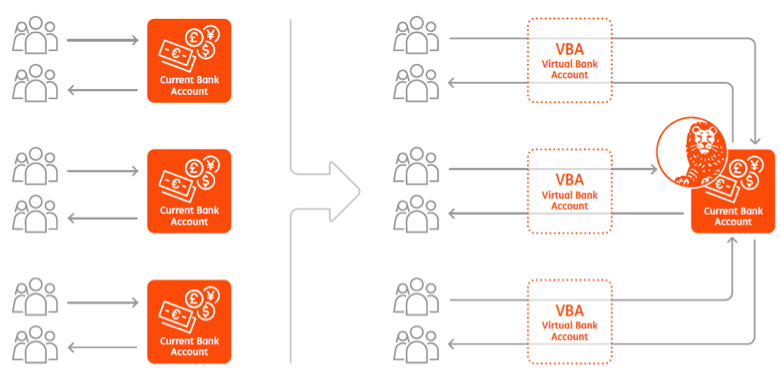Virtual bank accounts: forget what you thought you knew
Virtual bank accounts (VBAs) are a hot topic among the treasury community today. While you may have heard of VBAs before, their usage is rapidly evolving – and their benefits for treasurers continue to grow. Dick Oskam, global head of sales for transaction services at ING Bank, explains what VBAs are all about.
In an increasingly international marketplace, achieving centralised visibility, control and access to information is a significant challenge. This is where virtual bank accounts come in. Whether you’re new to VBAs, or are already familiar with the concept, there are a growing number of use cases and benefits to consider – as well as a few lingering myths to dispel.
Understanding the premise
So what are VBAs and how they work? After all, the concept means different things to different people.
The VBAs are bank-issued dummy current accounts that replace current physical accounts and instantly route payments and collections to a linked “master” current account.
Easily set up, VBAs can be allocated to any purpose – from denoting a legal entity or business unit to pinpointing individual payers. Every VBA has a unique number, which helps to separate funds in the master account.
The potential benefits include:
- the ability to centralise incoming and outgoing transactions and achieve cash concentration;
- straight-through reconciliation;
- reduced manual post-processing of unmatched items.
Since physical account structures can be rationalised and no balance is held on a VBA (as funds are directly routed to the master account), bank account costs and administration can also be significantly reduced.
Yet, despite the obvious advantages, the applicability of VBAs is sometimes underestimated.
Setting the record straight
A common misconception about VBAs is the type of company that they stand to benefit. While it’s clear how non-bank financial institutions may use VBAs to help allocate client monies, or how large collections businesses such as utilities or telecom companies can use VBAs to improve their complex reconciliation processes, VBAs are just as suitable for multinational companies (MNCs) in other sectors too.
For corporates with purely domestic cash flows and those with cash flows coming in from different legal entities, in disparate locations and denominated in various currencies, VBAs can help streamline cash management processes – potentially reducing the drain on experienced staff and minimising future investment in sophisticated ERP/TMS systems.
Another common myth surrounding VBAs is that they cannot be used on a cross-border basis. While this may be true at some banks, at ING, VBAs can be held in another country from the master account, as long as the accounts are in the same currency.
Take cash management to the next level
VBAs can also be combined with an allocated sub-account hierarchy – called virtual ledger accounts (VLAs) – which populate a multi-bank reporting dashboard, to deliver a complete virtual cash management solution (this has been done at ING).
This allows full cash concentration and visibility to be realised right across the group, no matter how the company’s treasury function is organised, or how sophisticated and harmonised its technology infrastructure is.
VLAs are administrative “sub-accounts” of one current account. Under the current account, clients can open, close and modify as many VLAs as they need, and organise account hierarchies to their liking. Funds and transactions can be earmarked as belonging to a VLA, allowing clients to allocate their funds without physically having to divide them.
As a result, treasurers can reap all the benefits of a structure that mimics physical bank accounts whilst harnessing the power of near real-time multi-bank data and reporting to make better informed decisions.
Moreover, corporates can set up an in-house bank, payments-on-behalf-of (POBO) and collections-on-behalf-of (COBO) structures – and multi-entity funds can be managed without the need for dividing cash physically.
More than a reconciliation tool
What all this highlights is that there’s much more to VBAs than meets the eye. Once the domain of pension funds and electricity suppliers, VBAs have a significant role to play in helping companies large and small, multinational and domestic, to improve their cash management.
Even those corporates already achieving high levels of centralisation can still benefit from VBAs. They can be used to replace physical accounts for tax or salary payments, for instance, which are often left out of the scope of traditional payment factories or POBO structures for legal reasons.
So, whether you want to kick-start your cash centralisation journey or looking for a solution to help tidy up any “loose ends” in your centralised structure, VBAs deserve a second look.














































Excellent explanation. I was particularly interested in the use case with regards to cross-border payments. I would be interested to see another article showing specific examples of the use of VBAs and VLAs.